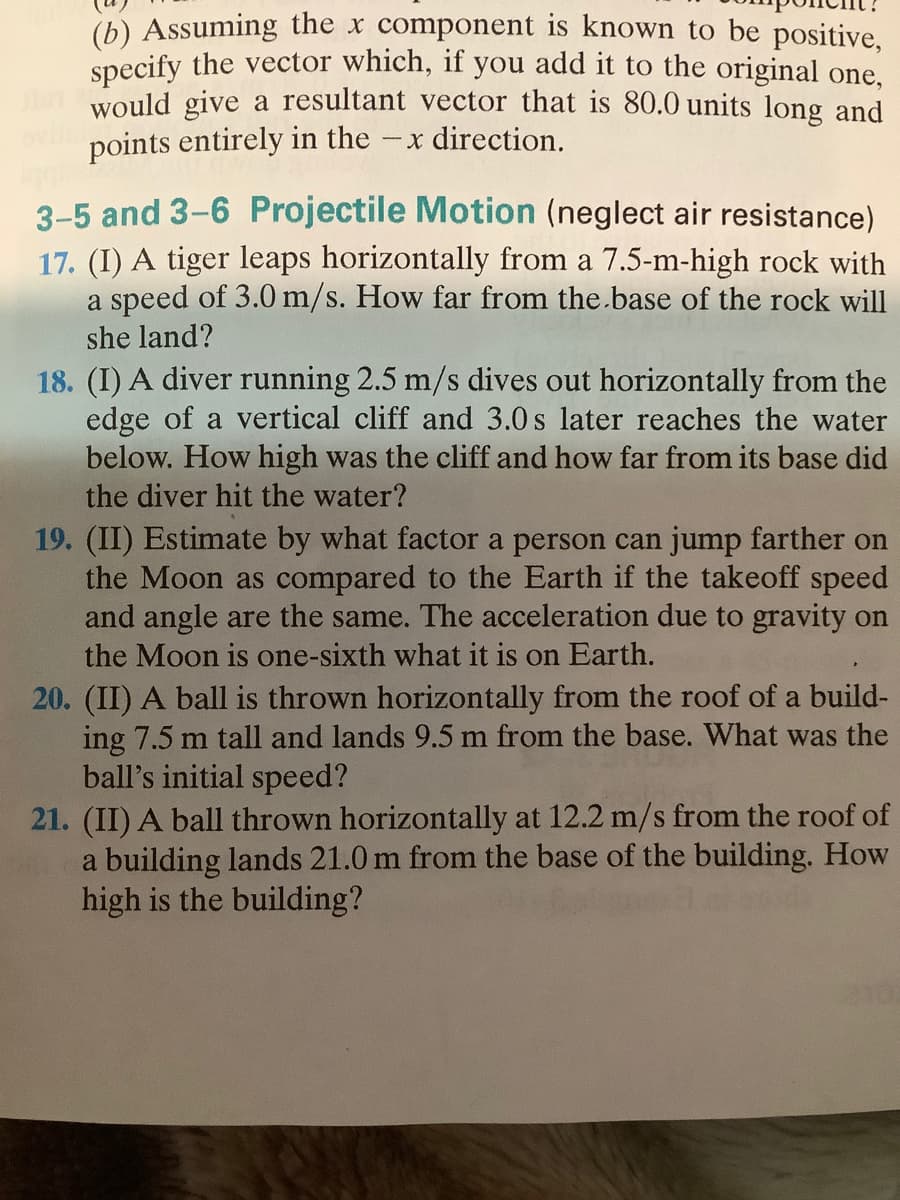University Physics Volume 1
18th Edition
ISBN:9781938168277
Author:William Moebs, Samuel J. Ling, Jeff Sanny
Publisher:William Moebs, Samuel J. Ling, Jeff Sanny
Chapter4: Motion In Two And Three Dimensions
Section: Chapter Questions
Problem 44P: The maximum horizontal distance a boy can throw a ball is 50 m. Assume he can throw with the same...
Related questions
Question
Number 20

Transcribed Image Text:(b) Assuming the x component is known to be positive,
specify the vector which, if you add it to the original one,
would give a resultant vector that is 80.0 units long and
points entirely in the
- x direction.
3-5 and 3-6 Projectile Motion (neglect air resistance)
17. (I) A tiger leaps horizontally from a 7.5-m-high rock with
a speed of 3.0 m/s. How far from the base of the rock will
she land?
18. (I) A diver running 2.5 m/s dives out horizontally from the
edge of a vertical cliff and 3.0s later reaches the water
below. How high was the cliff and how far from its base did
the diver hit the water?
19. (II) Estimate by what factor a person can jump farther on
the Moon as compared to the Earth if the takeoff speed
and angle are the same. The acceleration due to gravity on
the Moon is one-sixth what it is on Earth.
20. (II) A ball is thrown horizontally from the roof of a build-
ing 7.5 m tall and lands 9.5 m from the base. What was the
ball's initial speed?
21. (II) A ball thrown horizontally at 12.2 m/s from the roof of
a building lands 21.0 m from the base of the building. How
high is the building?
Expert Solution
This question has been solved!
Explore an expertly crafted, step-by-step solution for a thorough understanding of key concepts.
This is a popular solution!
Trending now
This is a popular solution!
Step by step
Solved in 2 steps

Knowledge Booster
Learn more about
Need a deep-dive on the concept behind this application? Look no further. Learn more about this topic, physics and related others by exploring similar questions and additional content below.Recommended textbooks for you

University Physics Volume 1
Physics
ISBN:
9781938168277
Author:
William Moebs, Samuel J. Ling, Jeff Sanny
Publisher:
OpenStax - Rice University

Principles of Physics: A Calculus-Based Text
Physics
ISBN:
9781133104261
Author:
Raymond A. Serway, John W. Jewett
Publisher:
Cengage Learning

Physics for Scientists and Engineers: Foundations…
Physics
ISBN:
9781133939146
Author:
Katz, Debora M.
Publisher:
Cengage Learning

University Physics Volume 1
Physics
ISBN:
9781938168277
Author:
William Moebs, Samuel J. Ling, Jeff Sanny
Publisher:
OpenStax - Rice University

Principles of Physics: A Calculus-Based Text
Physics
ISBN:
9781133104261
Author:
Raymond A. Serway, John W. Jewett
Publisher:
Cengage Learning

Physics for Scientists and Engineers: Foundations…
Physics
ISBN:
9781133939146
Author:
Katz, Debora M.
Publisher:
Cengage Learning